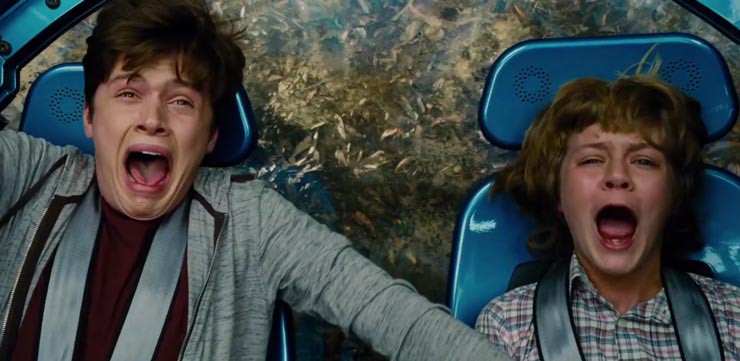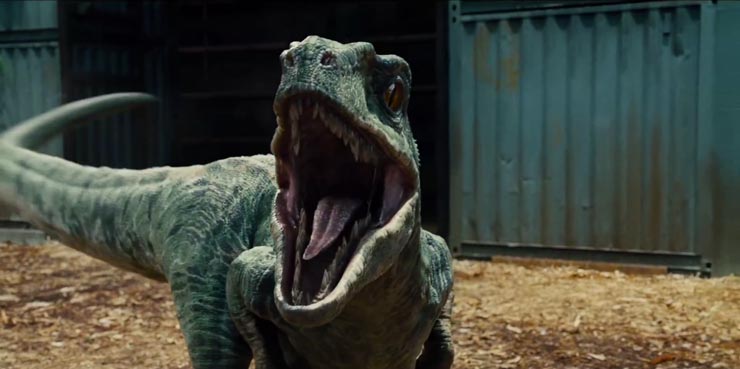In the summer of 1993 I would have been 11-years-old-about-to-turn-12. My sister was two years younger and terrified to see Jurassic Park because she’d heard it was “scary.” Calmly, I explained to her (lied) that for most of the movie the park operated just fine and it was only at the very end when the dinosaurs got loose. I’m not sure if she’s forgiven me for this.
Now, 22 years later the dinos are running amok again in Jurassic World and the result is totally a movie seemingly aimed at kids. Today’s kids will be terrified and also totally in love with this new crop of dinos. Is that a good thing, generally? Yes and no!
In the original Jurassic Park novel, Michael Crichton gives us a scene in which young Timmy talks to Dr. Alan Grant about the fact that he has “dinosaurs on the brain,” and in the opening of Jurassic World we’re given a similar dino-crazy kid in the form of young Gray (Ty Simpkins.) He’s adorable enough to remind you of your own-dinosaurs-on-the-brain phase, assuming you’re one of those people (like me) who had one. If not, then I suppose you’re meant to identify with Zach (Nick Robinson) who doesn’t give a shit about dinosaurs at all. This is essentially the way Lex behaved in the original Jurassic movie and book; she was pretty bored by dinosaurs until they started trying to kill her. Zach is the same.
But is everyone bored with dinosaurs in the world of Jurassic World? Early on, the movie telegraphs out this idea of thrill-fatigue when the manager of Jurassic World—Claire Dearing (Bryce Dallas Howard)—explains to various characters (and to us) just why it was time to create a brand-new crazy-killer dinosaur; the Indominus Rex. Apparently, the “wow” factor of dinosaurs is waning, so corporate investors have been called into fund a new hybrid dino that is more terrifying than anything we’ve ever seen. (Supposedly). One of Jurassic World’s technical workers (Jake Johnson) cynically jokes that they should just start giving “new” dinosaurs names to correspond with their corporate sponsorship, like “Pepsi-saurus” and so forth.
Throughout almost every scene which is not an action scene; Jurassic World seems to be having a conversation with itself (and us) about how awe and expectation are functioning in contemporary pop entertainment. In our world, big corporate blockbusters have to get bigger and louder with each year to excite us more and more, and in this fictional world, Jurassic World’s dinosaurs have a similar challenge. We’re told that “attendance has spiked” each time Jurassic World introduces a new “attraction.” How many different dinosaurs does it take to make everyone happy? How many different superheroes in our summer movies?
What’s successful about this critique is that a movie like Jurassic World has a distinct advantage in the spectacle department because its fantastical subjects (dinosaurs) are organic creatures which feel “real” in ways a robot or Thor never could. To put it another way: it’s way easier to be afraid of a velociraptor than it is one of Ultron’s robots because even though we’ve never seen a velociraptor in real life, we know they existed. Sure, there are tons of paleontological inaccuracies in Jurassic World, but that’s not really my point. Stop-motion dino legend Ray Harryhausen famously quipped that he didn’t “make movies for paleontologists.” Any of the “Jurassic” films are similar, with Jurassic World benefiting from the fact that a lot of movie-goers remember what the “first” velociraptors looked like, making these ones seem extra-real because they remind us of the original ones. Smartly, Jurassic World flips the raptor-paradigm: instead of strictly being the villains of the film, the raptors this time out are kind of the heroes.
If you’ve seen just one image from Jurassic World, what I’m telling you ruins nothing: Chris Pratt’s character Owen Grady has trained the raptors to basically do what he wants…most of the time. He’s the “alpha” in their little pack and all the four raptors have names: Delta, Blue, Charlie, and Echo. (Blue is my favorite! Blue is everyone’s favorite.)
And guess what? All the scenes in which he interacts with his clutch of raptors are completely awesome and 100% worth sitting through anything else in the movie you might not like. In probably the best, most well-paced chase sequence I’ve seen in a long time, Zach looks on in amazement as Chris Pratt rides a motorcycle alongside his raptor gang. “Your boyfriend’s a badass,” he says to Claire. And he’s right. How many people out there wish they had raptors they’ve trained, too? Hands up. Everybody? That’s what I thought.
The dinosaurs in Jurassic World look amazing. In the original film, John Hammond said that Jurassic Park “spared no expense,” and in the effects department in this movie that seems to be the case. It’s impossible to pick a favorite dinosaur scene in this movie because everything looks exactly right. I’m not saying the dinosaurs look “real” because I don’t think that’s actually what the 11-year-old inside of me wanted. Instead, the dinosaurs look correct. These are the dinosaurs I’ve been looking for and I loved every single second I got to hang out with them.
But what about the story? Or, to put it differently, does a movie like this succeed because it’s targeting contemporary 11-year-olds or simply pandering to 30-somethings like me who have internal 11-year-olds who control at least half of our opinions? Well, it’s here where Jurassic World betrays itself as pretty much only being a “ride” and not really much of a movie. Whereas the classic 1993 film featured two paleontologists and a mathematician as its primary human characters, Jurassic World’s heroes are an ex-Navy guy (Pratt) and a woman who works for corporate America (Dallas-Howard.) This seems like a step backwards. There is nothing wrong with being in the Navy or working for corporate America. That’s not what I mean. It’s just that some of the braininess of the old movies seems absent.
Plus, I imagine a lot of people are going to have problems with the character of Claire Dearing, and I can’t say that they’ll be wrong. While she did remind me of a lot of people I’ve known who work for big companies in real life, she’s certainly not a cool feminist icon in the mode of Mad Max’s Furiosa, nor does she come across as intelligent like Laura Dern’s original Jurassic Park character Ellie Sattler. And while we’re given homages to Fay Wray in King Kong, in terms of gender politics, this Jurassic movie seems to have taken steps back. Pratt meanwhile, is clearly the new Harrison Ford, and while hunky and funny as hell, he didn’t give me the same smart-sexy guy thing that both Sam Neill and Jeff Goldblum managed in the original film. Don’t get me wrong, I liked both Pratt and Howard in this movie and I actually totally bought their chemistry. It’s just that I also recognize it wasn’t that interesting, not bringing anything new to the table.
Anyone who knows anything about writing will notice that it seems like there are multiple scripts fighting against each other in Jurassic World. The Rise of the Planet of the Apes screenwriting duo of Amanda Silver and Rick Jaffa were originally hired to write the screenplay for Jurassic World, but subsequently left the project. The screenplay was completed by director Colin Trevorrow and his writing partner Derek Connelly. This too-many-cooks-in-the-dino-kitchen approach shows in the final story. Is this a movie about corporate espionage? Gene-splicing gone wrong? The military teaching dinos to retrieve torpedoes or other dipshit ideas? Just like the original Jurassic Park had dinos mutated from mixed-DNA, the script for Jurassic World seems to have similar inconsistent traits, causing it to occasionally head in various directions seemingly at once.
But, when Chris Pratt is steering his motorcycle and moving our raptors (go Blue!) toward victory, a lot of these issues take a back seat. Because while those raptors are leaping and the T-Rex’s jaws are snapping, I was cheering, crying, and jumping out of my seat in spite of myself. My sister and I were blissfully terrified by the original Jurassic Park in 1993; I’m sure you were too! And if that feeling is what you’re looking for in a movie, then, Jurassic World will make you feel like a kid again with one swipe of a raptor’s tail.
Ryan Britt is the author of Luke Skywalker Can’t Read and Other Geeky Truths out this November from Plume(Penguin) Books. He’s written (and wept) about dinos since before he can remember.












